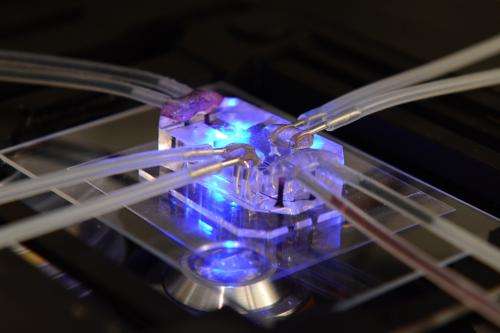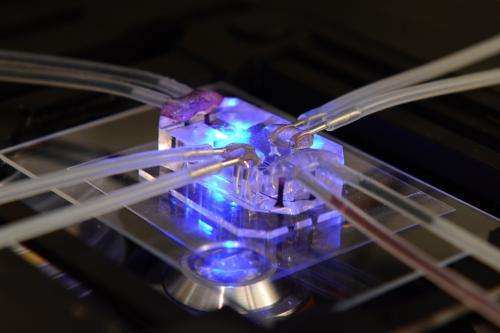Team to use 'organ-on-a-chip' microdevices to evaluate therapies for lethal radiation exposure

A team at the Wyss Institute for Biologically Inspired Engineering at Harvard University has received a $5.6 million grant award from the United States Food and Drug Administration (FDA) to use its Organs-on-Chips technology for a novel application of keen interest to national security and health officials: to test human physiological responses to radiation, and to evaluate drugs designed to counter those effects. The effort will also be supported by a team in the Vascular Biology Program at Boston Children's Hospital.
The multiyear project will investigate if Organs-on-Chips—tiny, microfluidic devices that are lined by living human cells and mimic complex organ physiology—can be used instead of animals to evaluate the efficacy and safety of medical treatments for radiation sickness, or Acute Radiation Syndrome (ARS). In addition to the ethical issues involved in animal testing, animal models often fail to accurately predict human responses—and human testing involving exposure to lethal radiation is not feasible.
ARS is a serious illness that occurs when the body receives a high dose of radiation, usually over a short period of time. Symptoms range from loss of appetite, fatigue, fever, nausea, vomiting, and diarrhea, to seizures, coma, and death. The project is part of the FDA's Medical Countermeasures Initiative (MCMi), which it launched in 2010.
"One of the fundamental goals of the MCMi is to ensure that we are prepared to respond effectively to acts of terrorism that may involve radiological or nuclear attacks, and to incidents such as the Fukushima nuclear disaster in Japan in 2011," said Luciana Borio, Head of the FDA program. "We have a lot to learn about the human physiological response to radiation, and are excited to explore the potential of the Wyss Institute's novel human Organs-on-Chips in filling that knowledge gap in a safe and cost-effective way."

The Institute's Organs-on-Chips technology has been recognized internationally for its potential to replace animal testing and as a new way to model human disease, test new drugs, and screen for environmental toxins. Earlier this year the Institute's Lung-on-a-Chip received the 3Rs Prize from the UK's National Centre for the Replacement, Refinement and Reduction of Animals in Research (NC3Rs). The award followed a landmark publication in Science Translational Medicine demonstrating the team's success using the Lung-on-a-Chip to model human pulmonary edema—or 'fluid on the lungs'—and to test potential new drug therapies under development.
"We currently have over ten different organs-on-chips in development, and are excited to work with the FDA to explore a new way to rapidly identify radiation countermeasures without having to rely on animal studies," said Wyss Institute Founding Director Don Ingber, M.D., Ph.D. who leads the Organs-on-Chips effort at the Institute.
Three Organs-on-Chips—designed and fabricated using computer microchip manufacturing techniques—are to be studied in the FDA-funded project. The three devices mimic human bone marrow, gut, and lung organ structure and physiology. These organ systems are most susceptible to the toxic effects of radiation in humans, particularly because of exposure to airborne particulates in the case of the lung, and the extremely high cell turnover rates in the case of the gut and bone marrow.
"Our Organs-on-Chips enable us to investigate how specific human cell types and organ systems respond to radiation—something very difficult or impossible to mimic in animal studies," said Wyss Senior Staff Scientist Tony Bahinski, Ph.D., M.B.A., F.A.H.A. who is helping to lead this project. The effects of radiation and organ-level responses to potential radiation therapies can be observed in real time; the microdevices—about the size of a memory stick—are made of a clear, flexible polymer and can be attached to sophisticated imaging equipment.
The Lung-on-a-Chip recreates the way the human lung physically expands and retracts when breathing, and the Gut-on-a-Chip mimics the peristaltic motions of the gut. This ability to recreate the physical microenvironment of living organs enables the Organs-on-Chips to recapitulate functions with a fidelity not possible in conventional culture systems, and it represents a key advantage of these novel bioinspired microtechnologies.
The bone marrow chip employs a unique approach to organ-chip design in which the team uses tissue engineering to form a whole bone with an intact marrow in vivo—and then surgically removes it and places it under microfluidic conditions in the laboratory. From there it can undergo testing in response to radiation and radiation therapies.
"We should have a much better understanding of how our bones, intestines, and lungs respond physiologically to radiation and radiation therapies at the conclusion of this project," Bahinski said.
In addition to the FDA, the Wyss Institute acknowledges support for its organs-on-chips technology from the Defense Advanced Research Projects Agency (DARPA) and the National Institutes of Health (NIH), which led to the development of these devices.


















